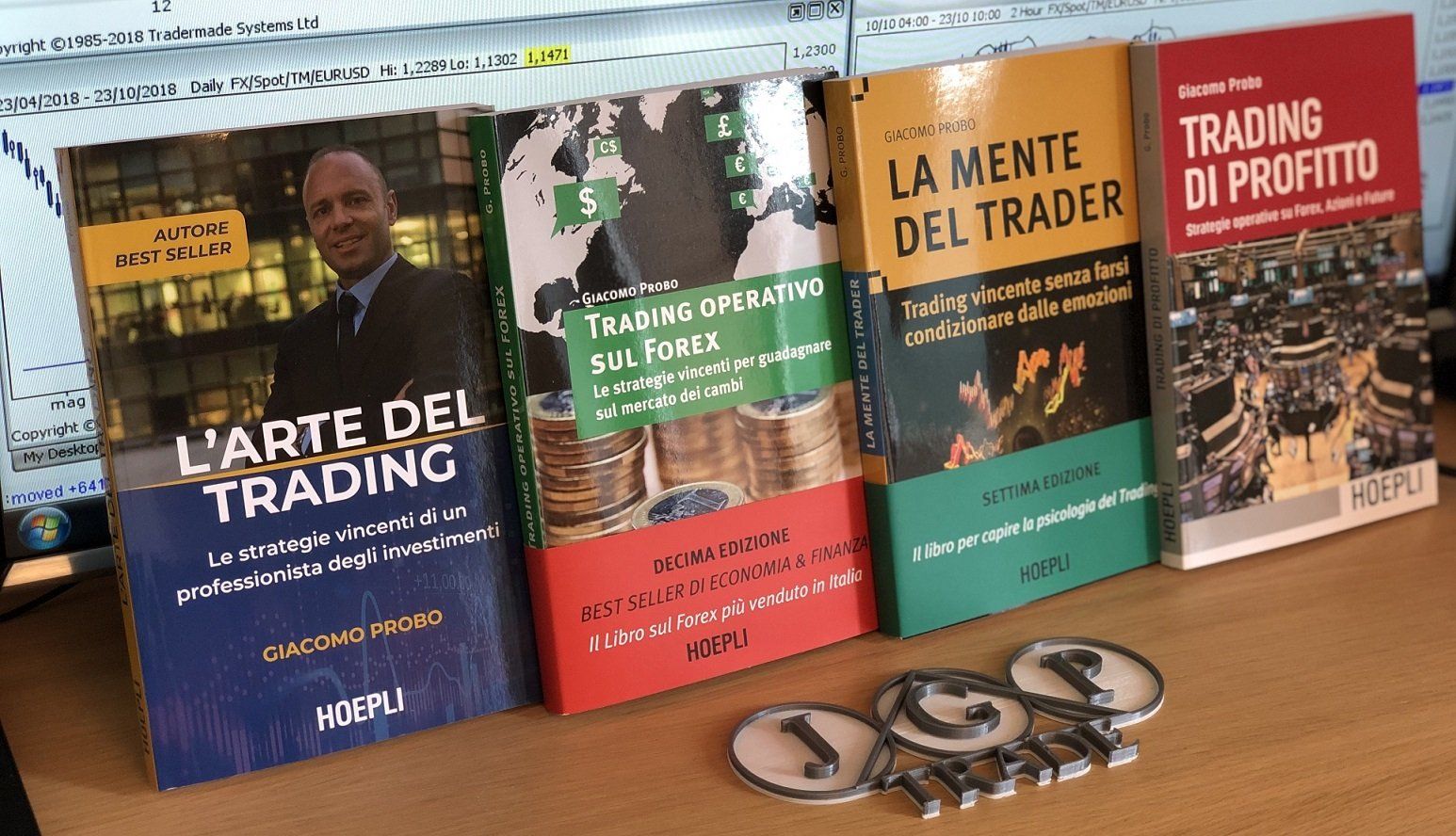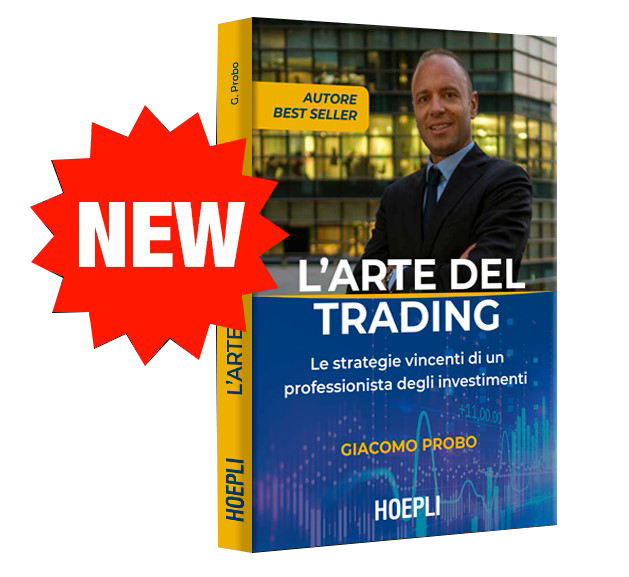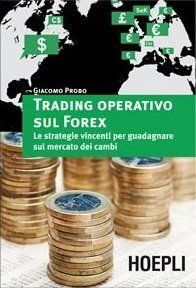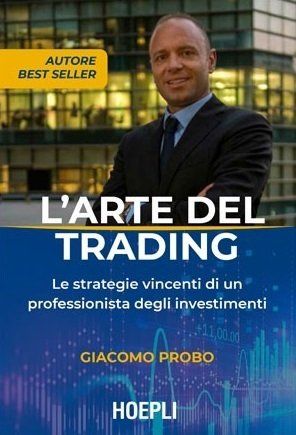Giacomo Probo's books

Available in the best National Bookstores and on the Internet on the site:
Operational Trading on Forex (Now in its 10th reprint and best-selling Forex book in Italy from official data)
The Mind of the Trader (Now in its 9th Edition)
Profit Trading (Now in 4th Edition)
Profit Trading (now in 2nd Edition)

Slide title
Scrivi qui la tua didascaliaButton
Slide title
Scrivi qui la tua didascaliaButton
Slide title
Scrivi qui la tua didascaliaButton
Slide title
Scrivi qui la tua didascaliaButton
The best-selling Trading Books in Italy

Trading operativo sul FOREX di Giacomo Probo
This book is an indispensable guide to understanding the functioning and behavior of Forex, a market on which currencies from all over the world are traded 24 hours a day. The initial part describes the characteristics of this market (Over The Counter) and then moves on to a more operational analysis, identifying the macroeconomic variables that affect the behavior of exchange rates and the correlations existing between the various currencies.
-
KEEP READING
The volume focuses on the methodologies of Technical Analysis (Basic Technical Analysis, Oscillators, Moving Averages, Japanese Candles, Elliott Waves, Advanced Technical Analysis, Money Management), explaining how to study the past behavior of prices, both on a daily basis. and at an intraday level, to try to anticipate future developments. It is therefore also suitable for those who trade in other markets outside of Forex.
Written with a clear style and suitable for everyone, the text is easy to read even for the less experienced on the subject, thanks to the numerous examples taken from the author's daily operations and the construction of simple but valid strategies on the main currency crosses.
Preface by Gianluca Defendi
Technical analyst of MF - Milano Finanza
Over the last few years, the world of online trading has experienced very important changes.
From simple position trading on the stock market, we have in fact passed to intraday, increasingly pushed, which first affected the future markets and then the Forex. The latter, in particular, has recently experienced a real explosion, favored by an increasingly complete offer from part of international brokers. The factors that have contributed to this spread are many:
• the high liquidity, guaranteed 24 hours a day, which allows the investor to be able to operate in any moment, with the guarantee of instant execution;
• the possibility of operating even with reduced capital, using the strong financial levers offered by the various intermediaries;
• the strong volatility that characterizes some currency pairs and provides numerous operational opportunities during the same day (just think of the strong fluctuations that occur following the dissemination of important macroeconomic data);
• low brokerage costs, which have been reduced to a minimum and are represented solely by the bid / ask spread quoted by your broker;
• the possibility offered by the foreign exchange market to gain both during the bullish and during the bearish phases, since, when one currency is bought, another one is sold at the same time. Furthermore, given its highly speculative nature, Forex is a very technical market and therefore, to obtain stable profits over time, those who work there need a solid operating methodology. From this point of view, the Probo book is a complete and exhaustive tool, as it allows you to understand all the factors that influence the trend of prices in the short and medium term. In particular, it should be noted that currency crosses are generally very directional, i.e. they tend to follow a trend, positive or negative, for a long time. Based on this assumption, the investor must necessarily know the various graphic configurations (triangles, head and shoulders, flags) and the main quantitative indicators (Rsi, Macd, Stochastic) that signal the presence of a main trend, warn when situations have arisen. of excess and identify potential reversal points. The book focuses precisely on the main methodologies of Technical Analysis whose premise is to study the behavior of prices in the past in order to try to anticipate future developments.
Among the various techniques explained in the volume, the candlestick analysis deserves special attention, i.e. the analysis of the currency market conducted through the various patterns of Japanese candlesticks (engulfing, doji, morning / evening star, etc.). The latter is in fact very useful for analyzing the behavior of prices and obtaining valid operational insights.
Finally, it seems useful to point out chapter 9 in which the author describes in a precise and precise way his daily operations, built through some simple but valid operational strategies.

La Mente del Trader di Giacomo Probo
The book is an indispensable guide to understanding the behavior of financial markets both from an operational and a psychological point of view. The author describes the various mental situations (fear, fear, anxiety, caution, optimism, euphoria, elation) in which each investor can find himself and which can therefore affect his operating choices.
-
KEEP READING
The first part of the volume highlights how the human mind relates to money, investments and trading in general. In particular, the various psychological steps that occur before, during and after each trading operation are described. From this point of view, some mental strategies that can be adopted to set up a profitable trading activity are illustrated in detail.
Next, it is explained how the psychological cycle affects the behavior of the financial markets and the general economic trend.
In the central part of the volume the main operational techniques provided by the technical analysis are then analyzed, analyzed from a psychological and technical point of view. The detailed analysis of the graphic patterns obtained with Japanese candlesticks, of the market movements identified with the Elliott waves and of the indications provided by the main quantitative indicators will be considered. Each situation will be analyzed, from a graphic-operational point of view, but also from a psychological point of view, with the aim of highlighting the dynamics and market forces that have created a certain technical situation and how the investor can exploit them at his own pace. advantage to build a viable operating strategy of profit. With the help of the analysis of the volumes and some practical schemes, real practical cases will be described, drawn from the author's personal experience. In this way the reader will be able to understand what were the mental and operational dynamics that determined his choices.
Preface by Giuseppe Di Vittorio
Journalist of Mf-Milano Finanza and TV Class CNBC host
A book that reviews the main technical analysis strategies from the psychological point of view? It is certainly very useful since the operation that focuses on these strategies and graphic configurations generates great concern among investors. Some traders believe that chart patterns don't work, others that financial markets are being manipulated. The truth is, many investors can't handle the psychological burden that each trade brings. There are two main problems: the first is knowing how to cope with losses and the second is managing positive results.
But let's go step by step, trying to understand what are the psychological, mathematical and even mental limits that condition the operation of the various operators and what are the remedies to overcome them.
Sheep trading. The most classic marketing rules tell us that the human being has three characteristics: he is a "sheep", selfish and emotional. To describe these concepts in a few words, we can say that the human being tends to copy the mass, following fashion. Secondly, the human being intervenes only if it suits him and, ultimately, his psychophysical state tends to change according to the external conditioning he undergoes. In daily life these three aspects push the human being to make wrong choices, and on the financial markets these choices lead to unsuccessful results.
In fact, being a "sheep" conditions market entrances, since the average investor tends to enter the position when the markets have already made a significant move and are approaching a possible reversal point. In particular, most of the small investors enter the market upwards at the end of a positive trend: this is due to the fact that all those who could buy have already done so and there can no longer be any force capable of sustaining a further I stretch. Similarly, small traders enter bearish (or close their long positions) at the end of a bearish trend, when all sellers have run out of ammunition, with the market approaching a major low and subsequent rally. . The other two defects, selfishness and emotionality, immediately liquidate profit-making operations due to the haste to monetize the positive outcome of the operations and in the event of an error not to stop loss-making operations.
When the brain lies. Some analyzes have shown that novice traders, often losers, tend to make trades following the impulses that start from the peripheral part of the brain, the one linked to emotionality. The most correct stimulus, on the other hand, is the one that comes from the central part of the brain, the area of rationality and above all of memories: this part is the one most used by the professional trader. This type of approach was revealed by the work of several Italian universities which involved the faculties of Economics and Medicine. Professional traders and inexperienced investors were subjected to magnetic resonance imaging with which it was possible to monitor which part of the brain works the most, because it is supplied with more blood.
It is mathematics that condemns him. With the personality characteristics and the mechanics of the brain filed away, there is a third reason that explains the losses generated by trading activity. The reason is mathematics. The stock market, and more generally the financial markets, are not a mathematically fair "game". What does it mean? A game, to be fair, should pay a percentage equal to the probability of losing. Every time you open a trade in the market, you have a 50% chance of losing and a 50% chance of winning. However, it is difficult to obtain a return of 50% with a single operation (and even if there were such an opportunity, one would tend to close the operation much sooner). The reasons for the early closure are related to greed, time and market dynamics. When you make a profit, you tend, out of selfishness, to monetize the result immediately, for fear that the market will reverse its direction. Secondly, there is the time factor: to reach 50% it takes too long a period, since not even the most volatile instruments can boast this kind of performance. Thirdly, before reaching 50% there are very important opposite fluctuations that make the closing of the operation inevitable.
The only way to improve results is to control as much as possible the level of risk to which you are exposed when operating on the markets.
And, from this point of view, the economic literature has decoded at least six strategies.
The stop. The most classic is that of the stop loss and it is worth dedicating a few words to it. The stop serves to protect oneself from the risk of ruin, or from an irreversible erosion of capital, which makes it very difficult to recover the losses suffered. The stop loss also serves to correct the distortion of the game of probabilities present in financial transactions. If the risk of loss becomes less than the potential gains the game, from a theoretical point of view, could remain in balance and, in the long term, become "honest".
Another merit of the stop is to give certainty to an operation: while the gain and the time to carry it out are uncertain; the loss, by setting a stop, takes on a well-defined dimension. Stopping is essential and is what distinguishes novice investors from a professional trader. Both can obtain positive results but the difference is that the first takes an indefinite risk and obtains mixed results, the second has absolute control of its positions and manages to obtain stable and constant results over time.
Price pattern. Another practice used by traders is the use of price patterns, which are some recurring graphic configurations that markets tend to draw repeatedly over time. These figures have the advantage of offering the investor precise entry points, with pre-established stop losses and target prices.
Enter on the retracements. One of the most used entry techniques is the one that is based on retracements, or on market rebounds. In the first case, prices, which come from a bullish phase, are expected to undergo a rapid correction, while in the second case, prices, which originate from a bearish trend, make a rapid technical rebound. From an operational point of view, the correction and the rebound can be used to enter, in the first case upwards and in the second downwards (short), following a pattern typical of trend following strategies. This technique, combined with the identification of a correct stop loss, very often gives interesting operational signals.
Split the position. Every trading strategy assumes an entry point, two exit points, (the first more affordable, the second more ambitious) and an initial stop loss. With the half position technique, half of the position is liquidated when the first target is reached. The other half position is left to run as much as possible (by raising the stop loss to break even, in order to avoid the danger of suffering a loss), with the aim of obtaining a profit that is as consistent as possible.
Performance. In order to stabilize the positive performance on the markets, it is important to note one's operations. Often we tend to perceive results that are very different from the real ones. For this reason, transcribing your operations serves to correct any errors.
Confront. Finally, it can always be useful to compare one's operations with that of other investors, in a sort of group therapy. If you do not know anyone willing to make their operations known, then it may be useful to attend a trading room or use some virtual instrument.
Probo's book addresses all these issues, helping the reader to understand the technical and emotional aspects of trading and allowing to improve the approach to financial markets thanks to the precise exposure of those strategic and psychological dynamics that the author himself uses in his trading. daily.

Trading di profitto di Giacomo Probo
The book describes numerous strategies that are used daily by the author to operate on different financial markets (Forex, stocks, Futures). The various chapters describe interesting trading techniques that can be used both by the expert trader, looking for new operational ideas that can allow him to improve his results, and by the novice trader, who instead wants to acquire a complete methodology of technical analysis.
-
KEEP READING
The author exposes some operational set-ups obtained by combining the graphical analysis (for example the Heiken Ashi technique) with the signals provided by the various technical oscillators (Bollinger Bands, Stochastic Oscillator).
The volume is full of graphic examples that allow you to learn operational strategies with a certain ease and to be able to evaluate their effectiveness. The final chapter is definitely interesting, where some transactions carried out with real money are analyzed in detail: this allows the reader to understand the principles that guide the author's decisions and to identify with his operations.
Prefaceby Emerick De Narda
Economic-financial journalist of Milano Finanza and host of Class CNBC
In the Italian panorama of online trading there are many specialists who write about finance, but few are those who really put money on the market, who know what it feels like emotionally to have a part of their money frozen in the stock market, grappling with the moods of buyers and sellers, at the mercy of trends, fluctuations, false signals. It is an all-encompassing experience. Many have given up, while also remaining with good results in the financial sector. The psychological pressure is high and is always present in a trader's day. On the other hand, the stakes are high. For those who have decided to make online trading their main job, not only their future is on the plate, very often there is that of their family. Giacomo experiences these emotions every day, because unlike many others he really puts money on the market and knows what it feels like.
To testify there is above all his second literary effort, The mind of the trader, which describes in a precise and exhaustive way what goes through the head of an operator during the various phases of an investment, noting the techniques and methods of trading and Money Management that has acquired over 20 years of experience. The stock market, in fact, puts you in front of your weaknesses and it is not easy to accept them. First of all you need to know who you are, how much you can invest and how much risk you are able to accept and it is for this reason that it is essential to use correct Money Management.
A renowned Italian trader once told me that on the market "you have to take at least 70% of a move". I do not agree. It is not possible to absolutely quantify how long an operation can be held and what can be a satisfactory gain. This is too personal. First of all, you need to take into account your risk appetite. How can a person with a low risk tolerance be asked to hold a position more than his emotions allow him to do? Over the medium term, overdoing this will inevitably lead to the loss of one's money.
A few years ago I was offered the opportunity to teach some courses in operational finance to a class of undergraduates, during a summer campus. Not wanting to bore the kids with sleep-inducing lessons, it occurred to me to empirically make them understand what investing in the stock market meant in terms of emotions. So I went to buy a very simple heart rate monitor and, in turn, I made everyone wear it while they were operating on a demo account (but they didn't know this) opened with an online broker. The result was a "case study": some of them were absolutely unaffected by the tension generated by the market, while others saw their pulses increase as if they were at three quarters of a half marathon. It is an experiment that I invite you to do, because there is nothing that allows you to measure your "emotional degree" from trading more than the trend of your heartbeats.
Within this third book, Giacomo takes a step forward, putting his experience at the reader's service, providing the strategies that, according to him, have a greater operational value. Obviously there is no magic formula that always works, but based on operational and statistical rules we can recognize those graphic patterns and technical situations that present the best levels of risk / return. This book highlights, in particular, numerous operational techniques and the synergies between the various strategies that allow an excellent risk / profit ratio. There are many practical examples and I am sure that, sooner or later, the reader will come across one of the cases reported and it will be at that moment that he will understand the importance of the didactic contents presented by Giacomo in the various chapters.

L’Arte del Trading di Giacomo Probo
The book is aimed at the investor who wants to successfully operate on various financial markets (Forex, stocks, futures, commodities). The author illustrates the training path that must be followed in order to be able to build valid operational strategies for short / medium term trading, focusing on both the technical aspects (the choice of the broker, the use of an adequate trading platform, the knowledge of the fundamentals related to technical analysis) and psychological aspects, explaining the various errors that are often committed by traders and the solutions to be implemented.
-
KEEP READING
In the central part, various trading techniques are proposed that are based on the use of the graphic part combined with the signals provided by some technical momentum oscillators, which aim to identify the short-term trend followed by the various financial assets, and to indicate the signals trading operations.
The volume also exposes the indications coming from the examination of the volumes, which allow to quantify the consistency of the various movements made by prices. The trading strategies described can be used both by the expert trader, aimed at identifying new operational ideas that can allow him to improve his results, and by the novice trader, who instead wants to acquire a complete chart analysis technique to set up a profitable trading activity. . The final part also contains numerous practical examples, taken from the author's real experience, which allow the reader to see the various advanced methodologies described in the book applied.
PrefaceBy Prof. Luca Bagato
Catholic University Professor
It is not easy to reconcile the analysis of economic and financial facts with theory and it is even more difficult to find a point of contact between academia and advanced technical analysis.
In recent years, however, the evolution of behavioral finance, including from an operational perspective, has prompted universities and businesses to try to find out more about how financial market operators and institutions work.
Many operational trading experts were thus encouraged to write on the topics in question and the manuals, in some cases, were then useful not only for other market operators, but also for students, professors and enthusiasts of the subject.
Giacomo Probo is one of these experts who, with the fourth book (after "Operational Trading on Forex", "The Trader's Mind" and "Profit Trading") "The Art of Trading", further deepens the analysis of psychology , of the trader's emotions and illustrates with practical and clear examples the path that a professional trader must take, to strengthen his position and a novice trader to become a professional.
This is also achieved by showing the combined operating techniques that he uses daily in his trading.
In charge of Economics of Money and Financial Markets (module II) and of Microstructure and Analysis of the Liquidity of Financial Markets
I consider Giacomo's efforts a positive example in terms of completeness, clarity of presentation and serious in-depth analysis that helps to understand the trading facts and to bring the academic world closer to that of technical analysts, and professional traders, suggesting many food for thought. on the microstructure of financial markets, on the mental path of trading, on the quantitative approach and on the development of artificial finance, facilitated by the presence in his texts of many examples of true operational strategies that trading professionals use during their trading day.






